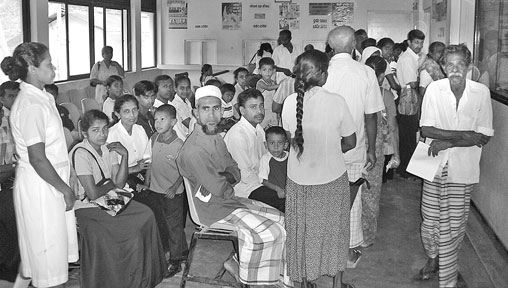|

Curbing NCDs in the South East Asian region :
Sri Lanka ahead in controlling communicable diseases
By Nilma Dole
The NCD problem
 Non-communicable diseases (NCDs) are the leading cause of death in
Sri Lanka, causing more death than all other causes combined. Commonly
known as chronic or lifestyle-related diseases, the main
non-communicable diseases are cardiovascular diseases, diabetes, cancers
and chronic respiratory disease. Such diseases could be significantly
reduced and prevented, with thousands of lives saved and untold
suffering avoided, through proven and affordable measures many of which
are complimentary to health efforts already underway. Non-communicable diseases (NCDs) are the leading cause of death in
Sri Lanka, causing more death than all other causes combined. Commonly
known as chronic or lifestyle-related diseases, the main
non-communicable diseases are cardiovascular diseases, diabetes, cancers
and chronic respiratory disease. Such diseases could be significantly
reduced and prevented, with thousands of lives saved and untold
suffering avoided, through proven and affordable measures many of which
are complimentary to health efforts already underway.
The knowledge and technology to fight the onset and effect of
non-communicable disease already exist. It's time to act to save the
future generations from the health socio-economic harm of such diseases.
Preventing and controlling NCDs will greatly depend on action taken
by non-health sectors. The health sector, acting alone, can't curb the
threat. All sectors of the government and the society must work together
to start fighting the epidemics of cardiovascular diseases, cancers,
chronic lung diseases and diabetes.
NCD prevention is everybody's business and every sector/partner can
help in the prevention and management of NCDs. Non-communicable diseases
have now become a development and political problem in addition to being
a public health problem of immense magnitude. That is why the UN general
assembly in September is focusing on NCDs because they threaten
development gains, particularly the MDGs (Millennium Development Goals)
addressing poverty and health problems.
|
Demographic and socio economic determinants in Sri Lanka
Total population in millions (2009)-20.2
Life expectancy at birth in years (2009)-71
Healthy life expectancy at birth in years (2008) -63
Percentage of population living in urban areas
(2009) -15
Adult literary percentage (2000-2008)-91
Total fertility rate per woman (2009)-2.3
Percentage of population living on less than one
dollar a day
(2000-2008)-14.0
GDP percentage on health (2008)-4.1
Percentage of out-of-pocket expenditure on health
(2008)-86.7
Number of doctors per 10, 000 population
(2000-2010)-4.9
Number of nurses per 10, 000 population
(2000-2010)-19.3 |
|
Demographic and socio economic determinants-Sri Lanka
Number of NCD deaths per year (in thousands)-118
Percentage of all deaths due to NCDs (2008)-65.4
Percentage of all deaths due to cardiovascular disease
(2008) -29.6
Percentage of all deaths due to respiratory diseases
(2008) -8.5
Percentage of NCDs arising out of the total country's
disease burden (2004)-50.9
Percentage of cardiovascular disease expenditure out
of country's NCD burden (2004)-16.9
Percentage of cancer expenditure out of country's
NCD burden (2004)-9.0
Percentage of diabetes expenditure out of country's
NCD burden (2004)-3.6
Percentage of prevalence of diabetes (2010)-10.9
|
|
Sri Lankan NCD risk factors
Unhealthy Diet - More than 80 percent of the adult population between
the age of 15 to 64 years are found to have an inadequate diet without
the recommended serving of fruits and vegetables.
Physical inactivity - Prevalence of low physical activity in Sri
Lanka was 33 percent in woman and 19 percent in men
Obesity - One-quarter of women (25 percent) and 17 percent of men are
overweight Alcohol consumption - More than a quarter of men (25 percent)
and just 1.2 percent of women are alcohol consumers Courtesy: Ministry
of Health |
 |
|
Dr. Firdosi Mehta |
Sri Lanka's health is the nation's wealth, but maintaining its
stringent health indices and keeping it at an optimum level is a
formidable task. While the country has successfully eradicated all
vaccinable diseases, reduced maternal mortality rates among other health
issues, Sri Lanka has effectively curbed and controlled communicable
diseases to a great extent as opposed to its neighbouring countries.
However, controlling and preventing NCDs or non-communicable diseases
is the battle we're facing now and if we don't address the issue, it
might be too late. WHO (World Health Organisation) representative in Sri
Lanka, Dr. Firdosi Mehta said that, "We applaud Sri Lanka for its joint
initiatives in combatting vaccine preventable and communicable diseases
but suffice to say, non-communicable diseases are brought on by society
itself."
It is imperative that society takes heed of NCDs by changing their
lifestyle instead of just accepting fate without controlling it.
He said, "Today, the common cause of all deaths is in the form of
heart attacks, strokes, diabetes - most of which are preventable and
curable".Sri Lanka has an impressive track record of achieving MDGs
(Millennium Development Goals) earlier than others in the South East
Asian region and as an emerging nation; the island has achieved
middle-income status in a short time.
However, the economy and health budget is at a risk of weakening
because a considerable portion of expenditure is wasted on health issues
that have to be nipped in the bud.
According to Dr. Mehta, non-communicable diseases (NCDs) are quickly
becoming the leading cause of death in Sri Lanka, causing more deaths
that all other causes combined. "Recent statistics show that Sri Lankan
women are more obese than men with nearly one-quarter of the population
of women being overweight," he said.
This goes to show that not just middle-aged women but newly-married
women too accept their fate as being 'fat' and don't do anything to
control it. Accepting your plump image after child-birth isn't healthy
at all for it can lead to other complications. Not investing a few hours
of exercise a day could lead to deadly diseases later which is a
money-burner.
In this aspect, the Ministry of Health together with the WHO and
other health authorities have started a campaign to make Sri Lanka a
path finder in NCD prevention. The theme will revolve around combatting
four deadly types of NCDs; this includes preventing cardiovascular
diseases, cancer, diabetes and respiratory diseases. The campaign will
focus on getting people to make the conscious decision to save their
lives by avoiding tobacco use, preventing alcohol misuse, eating
unhealthy diets and having an exercise regime in place.
The campaign puts into limelight the affect such diseases have on
society as it could be significantly reduced and prevented, with
thousands of lives saved and untold suffering avoided, through proven
and affordable measures.
The knowledge and technology to fight the onset and effect of NCDs
already exists without special requirements or expenses because it's
time now to act to save the future generations from the health
socio-economic harm of such diseases. In Sri Lanka, the action plan for
prevention and control of NCDs means that it's not just the public
blaming the government for not doing anything. As an individual, it is
our duty to ensure that we set our own standards of healthy lifestyles
and a health policy.
The NCD unit of the Ministry of Health together with various health
organisations and decision-makers are always here to help people with
advice on what is the best practice of having a healthy lifestyle.
'Gone are the days when people thought NCDs were a Western condition
and that it only affects those in the developed countries. Today, a
significant proportion of the Asian population is affected by NCDs and
with globalisation and modern trends, it has become a worldwide policy
to win the NCD war,' said Dr. Mehta.
Courtesy: Ministry of Health
Psychology:
Imitation may be the sincerest form of flattery
but clueless copycatting comes at a cost:
As anyone who has been subjected to the mocking playground game
knows, parroting can be annoying. Yet gentle mimicry can act as a kind
of "social glue" in human relationships.
It fosters rapport and trust. It signals cohesion. Two people who
like each other will often unconsciously mirror each other's mannerisms
in subtle ways - leaning forward in close synchrony, for example - and
that strengthens their bond.
 |
|
A form of imitation |
The benefits of body-language mimicry have been confirmed by numerous
psychological studies. And in popular culture, mirroring is frequently
urged on people as a strategy - for flirting or having a successful
date, for closing a sale or facing a job interview.
But new research suggests that mirroring may not always lead to
positive social outcomes. In fact, sometimes the smarter thing to do is
to refrain. In a study to be published in a forthcoming issue of
Psychological Science, it is noted that in real-life situations there
are often observers to the mirroring that takes place between two
people. This led them to wonder whether mimicry sometimes comes at a
reputational cost.
Are there cases in which an observer might actually think less of a
person for mirroring the behaviour of another? Results of three
experiments suggest that mimicry is more nuanced than previously thought
and not, the authors write, "uniformly beneficial to the mimicker."
"Mimicry is a crucial part of social intelligence," said Winkielman, UC
San Diego professor of psychology. "But it is not enough to simply know
how to mimic. It's also important to know when and when not to.
The success of mirroring depends on mirroring the right people at the
right time for the right reasons. Sometimes the socially intelligent
thing to do is not to imitate." Participants in the study were asked to
watch several staged and videotaped interviews. Some saw videos in which
the interviewer was cordial and others saw videos in which the (same)
interviewer was unfriendly. The people being interviewed in the videos
either mirrored the interviewer's simple mannerisms, such as
chin-touching or leg-crossing, or they did not.
After watching each video, participants evaluated the interviewee on
general competence, trustworthiness and likeability.Despite the fact
that the participants were not instructed to watch for mimicry and
reported no awareness of it, it still influenced their evaluations:
Interviewees who mimicked the unfriendly interlocutor were judged to be
less competent than those who didn't.
That is to say, in the eyes of the outside observers, the imitators
of the undesirable model incurred reputational costs - their
unconsciously observed mirroring registered as a kind of error.
In a second corollary experiment, participants were exposed to the
same videos but with the interviewer obscured. In other words, they
couldn't see any evidence of mimicry, and the results support the
researchers' hypothesis: It is not merely interacting with negatively
perceived people that has a social cost; you pay a price for aligning
with them through body language.
Interestingly, an additional experiment showed that the reputational
cost of mimicking an unfriendly interviewer disappeared when
participants read positive information about that interviewer - i.e.,
that he was engaged in humanitarian work - before watching the video.
"It's almost as though mimicry of a condescending interviewer was
forgiven when he was judged to be good at heart," Winkielman said. Our
social lives are incredibly complex, said Winkielman, and in order to
build or maintain relationships we have to keep in mind a variety of
factors.
"It's good to have the capacity to mimic," he said, "but an important
part of social intelligence is knowing how to deploy this capacity in a
selective, intelligent, context-dependent manner, and understanding,
even implicitly, when mirroring can reflect badly on you."
Source: Inga Kiderra University of California
Selecting a good backpack for children
 |
|
Source: Cincinnati Children’s Hospital
Medical Center |
Most children and teenagers carry their schoolbooks and other
supplies in backpacks during the school year. When used correctly,
backpacks are the most efficient way to carry a load and distribute the
weight among some of the body's strongest muscles. However, parents need
to carefully select a backpack to ensure that they are comfortable and
do not cause injury.
Simple guidelines have been put out to prevent any unnecessary
injuries throughout the school year:
* Look for a backpack that is lightweight - no more than 15-20
percent of body weight. It needs to have two wide and padded shoulder
straps, a cushioned back, and waist straps.
* Encourage children to use both shoulder straps and make sure the
straps are tight.
* Organise supplies and books so that the heaviest items are closest
to the centre of the back and all compartments are used.
* Persuade children to stop at their lockers often so they're not
carrying all of their books throughout the day.
*Remind children to bend using both knees when lifting a backpack.
* Remind children to not leave backpacks on the floor where others
can trip over them, and not to swing them around where they may hit
others. Back and shoulder discomfort is common with heavy backpack use.
If children complain of persistent back pain, consult with their
pediatrician or family physician.
Source: Cincinnati Children's Hospital Medical Center
Research reveals clues to the formation of heart, and other organs
How do the intestines in tiny birds or large mammals form intricate
looping patterns? How do hearts and vascular systems form? Why do some
large dog breeds succumb to gastric torsion while others don't?
Newly released research provides some key clues to these natural
phenomena.
The research is based on a model that mimics how developing
intestines in vertebrates form the characteristic looped pattern in the
body cavity.
That model not only provides a template for organ asymmetry; it also
could lead to better diagnosis of veterinary and human maladies such as
malrotation of the intestines in babies and gastric torsion in
large-breed dogs such as Labrador retrievers. "By understanding the
patterns of loops, we could better identify and more accurately diagnose
these conditions," research author Kurpios said.
"This also gives us hints to the formation of other organs, such as
the heart and the vascular system."
Source: Cornell University
|

